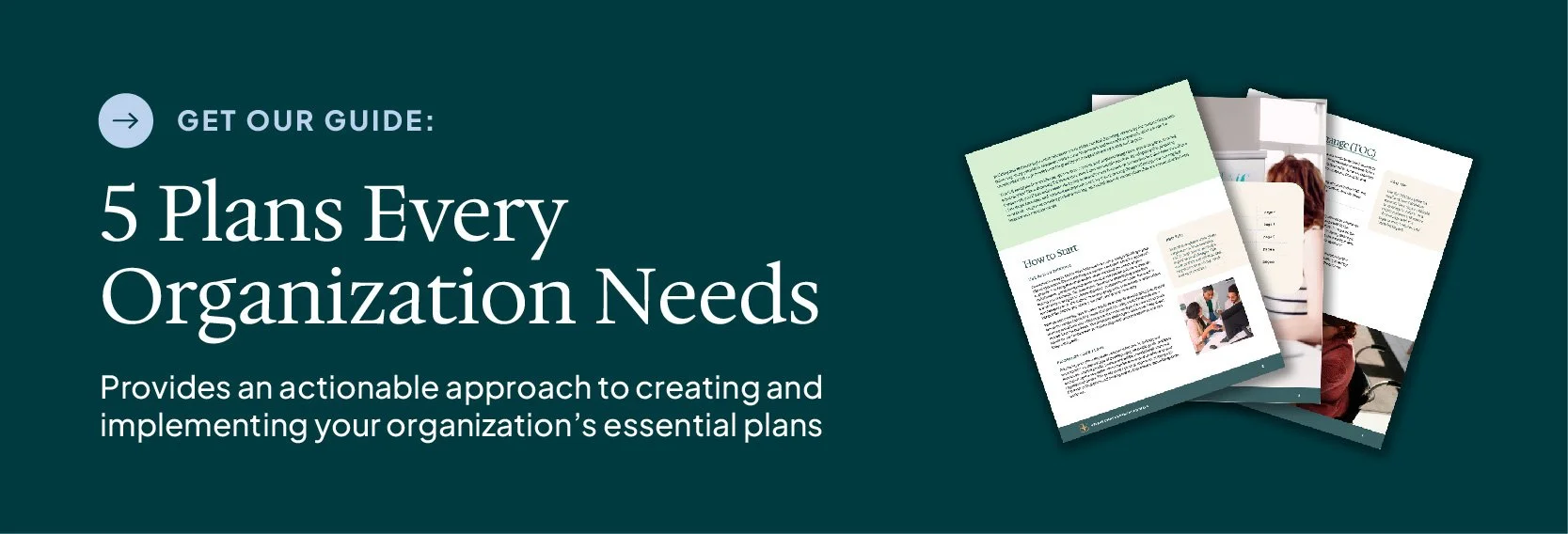Navigate Periods of Change While Maintaining Mission Focus Through Contingency Planning and Abundance Mindset
In times of volatility, nonprofits must strengthen their ability to adapt quickly — working on the business as much as in it. A disciplined contingency planning process ensures that when challenges arise, your leadership, staff, and board are ready to respond, not react.
Key Areas for Contingency Planning
Financial: Model multiple “what if” scenarios (e.g., 10%, 20%, 50% cuts in funding). Reforecast frequently and conserve cash.
Programmatic: Identify mission-critical programs, prioritize them, and prepare to scale back or pause others if necessary.
Staffing: Determine which roles are essential, consider temporary furloughs or consolidations, and plan for morale strategies.
Communications: Build rapid-response plans for policy shifts or public controversy.
Fundraising: Deepen relationships with current donors; anticipate donor fatigue or shifting priorities.
Operations: Streamline processes, automate where possible, and cross-train staff for flexibility.
Advocacy and Collaboration: Build coalitions, educate stakeholders, and explore merger or partnership strategies when appropriate.
Contingency planning should not only address risks. It should also prepare for potential opportunities — new partnerships, new funding sources, or emerging needs you are uniquely positioned to meet. Disruptions can open doors for innovation and growth when approached with a flexible mindset.
When contingency planning, identify the programs or services that must be preserved at all costs — your “untouchables.” These represent the heart of your mission and the highest impact for your community. Communicate these priorities clearly to staff, funders, and key partners.
During times of uncertainty, return to your mission and values often. Anchor every decision — from budget changes to new partnerships — by asking, Does this support or detract from our core purpose? Opening major meetings by briefly revisiting your mission statement helps maintain clarity and focus across your team.
Risk Prioritization Matrix
| Risk | Likelihood | Impact | Immediate Next Step |
|---|---|---|---|
| Reduction in government funding (e.g., 20%) | High | High | Reforecast budget with multiple funding scenarios |
| Major donor shifts focus or funding priorities | Medium | High | Deepen engagement with existing donors and identify backup prospects |
| Increased staff turnover or burnout | Medium | Medium | Implement staff well-being checks and retention strategies |
| Public controversy or policy threat | Low | High | Develop and rehearse a rapid-response communication plan |
Start by assembling a core team who will partner with you to create — and eventually execute — your contingency plans. Begin by brainstorming potential risks across all areas of your organization. Then, plot each risk by likelihood and impact to prioritize where to focus your efforts. Work through your highest-priority scenarios first, developing plans for the ones that are most likely and could have the greatest impact. Even if none of these scenarios unfold exactly as imagined, you will have built critical planning muscles as a team — giving you the ability to quickly regroup and respond when new challenges arise. Be sure to inform your board that you are developing contingency plans. As part of their governance role, they need to be in the loop, and they will appreciate the proactive, strategic approach you are taking to safeguard the organization’s future.
Leading with an Abundance Mindset
External threats naturally trigger fear — stimulating the amygdala, the brain’s center for the fight, flight, or freeze response. When fear dominates, trust erodes, creativity plummets, and problem-solving becomes difficult because the prefrontal cortex — responsible for reasoning, planning, and complex thinking — is under-activated.
To counteract this, nonprofits must intentionally cultivate an abundance mindset across leadership, staff, and board. Focusing on joy, gratitude, and opportunities even during uncertainty can calm the amygdala and stimulate the prefrontal cortex, enabling better decision-making and stronger collaboration.
Practical Ways to Build Abundance
Here are some practical suggestions to build an abundance mindset:
Create short rituals that spark gratitude at staff meetings (e.g., sharing one success story or “gratitude round”).
Celebrate small wins consistently, even in tough times.
Incorporate “joy checks” — questions like What opportunity are we excited about today? — into leadership discussions.
Reflect on your organization’s unique strengths and impact regularly to reinforce a sense of possibility.
Building resilience is not just about managing risk — it’s about nurturing the mindsets and cultures that help your organization rise stronger, no matter what challenges come.
Together, we are stronger.
If you’re interested in contingency planning or need support in balancing your mission and business strategies, we’re here to help.
Mission + Strategy is an invested thought partner to your nonprofit organization. Through our Strategic Advising, Mergers & Partnerships, and Shared Back Office service solutions, we help nonprofits achieve alignment between their mission and business strategies.










